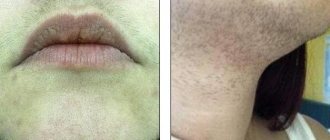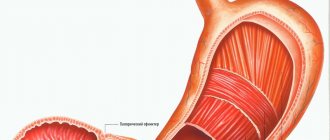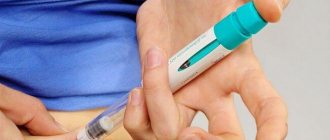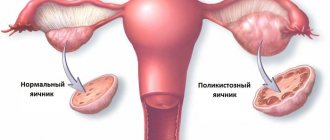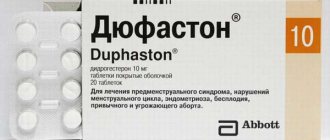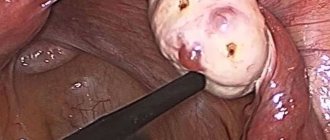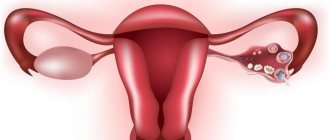About 8% of women of childbearing age suffer from polycystic ovary syndrome. The pathology is manifested by various menstrual cycle disorders that cause infertility.
It is impossible to say whether polycystic ovary syndrome can be completely cured. However, modern medicinal methods of correction in combination with surgical intervention can significantly reduce the manifestations of PCOS and make it possible to get pregnant.
What is polycystic ovary syndrome
Polycystic ovary syndrome is a pathological process occurring in the gonads, which is characterized by the formation of multiple cysts. It is believed that PCOS is becoming one of the common causes of infertility.
Women who want to get rid of pathology often do this due to the inability to get pregnant.
Features of the proper functioning of the female reproductive system lie in the cyclic production of hormones that control various processes.
In a healthy woman, an undisturbed balance of regulatory substances is determined: in the first half of the cycle, FSH is produced, which is replaced by LH, and after ovulation, progesterone comes into play. The relationship between the hormones produced is inextricable.
It is necessary to carry out the main task - conceiving and bearing a child. When hormone levels begin to “dance,” secondary problems appear. The mechanism of development of PCOS suggests several options:
- the production of gonadotropin-releasing hormones is disrupted, LH increases and hyperandrogenism develops,
- insulin resistance provokes a violation of glucose metabolism, due to which androgens are synthesized and LH increases,
- a decrease in estradiol provokes a decrease in the production of sex steroids that bind globulin, resulting in high levels of testosterone,
- With excess body weight, fat cells synthesize androgens and testosterone, which are converted into estrone.
The outcome of any mechanism for the occurrence of the disease is a distortion of the hormonal background, which prevents the follicles from opening in a timely manner, and a follicular cyst is formed from them.
Who treated polycystic disease without hormonal drugs?
They made this diagnosis and prescribed it to Diana. It happens that there are no periods for more than half a year, and they come only after Duphaston, pain in the lower abdomen, huge stretch marks on the chest, weight + 6-7 kg, body hair grows quickly, nausea, terrible fatigue and a lot of vascular network. Has anyone had this and managed without hormonal medications?
Woman.ru experts
Find out the opinion of an expert on your topic
Zinovieva Natalya Yurievna
Psychologist. Specialist from the site b17.ru
Dyachenko Elena Vladimirovna
Psychologist, Gestalt therapist in training. Specialist from the site b17.ru
Slobodyanik Marina Valerievna
Psychologist. Specialist from the site b17.ru
Nikulina Marina
Psychologist. Specialist from the site b17.ru
Sheludyakov Sergey
Psychologist, Clinical psychologist. Specialist from the site b17.ru
Trifonova Maria Anatolyevna
Psychologist. Specialist from the site b17.ru
Gundertailo Yulia Danilovna
Psychologist. Specialist from the site b17.ru
Vyacheslav Potapov
Psychologist, consultant. Specialist from the site b17.ru
Wrzecinska Eva
Psychologist. Specialist from the site b17.ru
Natalya Maratovna Rozhnova
Psychologist. Specialist from the site b17.ru
I have polycystic ovaries after hormonal Jasm, which turned into oncological ovaries. I went to eight gynecologists, they all looked at ultrasound and didn’t see niphren until I myself read on the Internet about a computed tomograph of the pelvis and abdominal organs, I had it done at my own expense and they immediately told me - you have tumors in the ovaries, one is a metastasis. When I went for chemistry, there were a lot of women near me with stage 3-4 ovarian cancer, because no one pays attention to the ovaries, so almost all women are in such advanced stages, which is why the mortality rate from ovarian cancer is the highest. All the crappy doctors only know about polycystic ovaries, cervix and uterus, they have no brains about anything else. So, author, saving drowning people is the business of the drowning people themselves. The worst thing is that I had the same symptoms as you. Up to nausea and rapid hair growth.
I read in a foreign magazine that polycystic disease is a symptom of insulin resistance.
I read in a foreign magazine that polycystic disease is a symptom of insulin resistance.
In fact, it can be treated. But! First, you MUST PASS ALL EXAMINATIONS BY A DOCTOR! Ultrasound OMT, complete. analysis of hormones, etc., you will have to run around. Polycystic disease is generally incurable, because This is not a disease, but a malfunction in the body. S-but in order to improve the body, it is necessary to take measures: sports for at least 40 minutes a day, every day, contrast shower, diet with a mandatory list of products, healthy sleep, exclusion of sugar, salt and high-eating foods. GI. And definitely some herbs. Google it yourself, I don’t want to advertise. I buy some things at the pharmacy, some from Iherb. It's difficult, but possible. Prepare for the fact that you will have to maintain a healthy lifestyle for the rest of your life.
P.S. While on hormone treatment, I managed to acquire cellulite, stretch marks, and lost 10 kg. excess weight. She gave up and began to heal herself. The cycle is now stable, but I also make a lot of efforts for this. Hormones do not cure, they are used only in extreme cases - so that the cyst resolves. From Diane-35 I had severe swelling and cellulite. Decide for yourself.
I have polycystic ovaries after hormonal Jasm, which turned into oncological ovaries. I went to eight gynecologists, they all looked at ultrasound and didn’t see niphren until I myself read on the Internet about a computed tomograph of the pelvis and abdominal organs, I had it done at my own expense and they immediately told me - you have tumors in the ovaries, one is a metastasis. When I went for chemistry, there were a lot of women near me with stage 3-4 ovarian cancer, because no one pays attention to the ovaries, so almost all women are in such advanced stages, which is why the mortality rate from ovarian cancer is the highest. All the crappy doctors only know about polycystic ovaries, cervix and uterus, they have no brains about anything else. So, author, saving drowning people is the business of the drowning people themselves. The worst thing is that I had the same symptoms as you. Up to nausea and rapid hair growth.
Good afternoon Look at the link https://www.coral-best.com/Lechenie/Protivovospalitelnaya.htm, I will say for myself that these drugs help. A friend had a polyp, they were preparing for surgery - no longer, the gynecologist’s eyes popped out of her head, I had problems with the thyroid gland - everything is also fine, hormones are normal and so is the thyroid gland.
7-from the phone does not open. What's there? Can you briefly describe it?
and today I was prescribed duphaston to induce m, then femoston 2/10, folic and chimes, they said this is preparation for pregnancy, damn it, fucking polycystic disease. in short, it is treated with hormones, by the way, I also took them, and about excess weight, as far as I was told, it appears if the pancreatic hormones are not in order, take insulin and have it checked.
I have been taking Jess for more than 1.5 years. Everything is good, and most importantly, convenient. There is no need to count the days, no need to torment your husband with PPA and condoms. I’m just very grateful to my gynecologist for the appointment.
I have been taking Jess for more than 1.5 years. Everything is good, and most importantly, convenient. There is no need to count the days, no need to torment your husband with PPA and condoms. I’m just very grateful to my gynecologist for the appointment.
P.S. While on hormone treatment, I managed to acquire cellulite, stretch marks, and lost 10 kg. excess weight. She gave up and began to heal herself. The cycle is now stable, but I also make a lot of effort for this. Hormones do not cure, they are only used in extreme cases - so that the cyst resolves. From Diane-35 I had severe swelling and cellulite. Decide for yourself.
Which doctor should I see next? I visited almost all the famous doctors in our city, all without tests, only after examination and ultrasound they diagnosed polycystic disease, I didn’t pay attention to stretch marks and hair and constant pain. I also have cutting pains during sex.
P.S. While on hormone treatment, I managed to acquire cellulite, stretch marks, and lost 10 kg. excess weight. She gave up and began to heal herself. The cycle is now stable, but I also make a lot of efforts for this. Hormones do not cure, they are used only in extreme cases - so that the cyst resolves. From Diane-35 I had severe swelling and cellulite. Decide for yourself.
Please tell me how you were treated? I beg you!
They made this diagnosis and prescribed it to Diana. It happens that there are no periods for more than half a year, and they come only after Duphaston, pain in the lower abdomen, huge stretch marks on the chest, weight + 6-7 kg, body hair grows quickly, nausea, terrible fatigue and a lot of vascular network. Has anyone had this and managed without hormonal medications?
Good afternoon Look at the link https://www.coral-best.com/Lechenie/Protivovospalitelnaya.htm, I will say for myself that these drugs help. A friend had a polyp, they were preparing for surgery - no longer, the gynecologist’s eyes popped out of her head, I had problems with the thyroid gland - everything is also fine, hormones are normal and so is the thyroid gland.
You may be interested in: How to avoid gaining weight while taking hormones
Olga, what kind of method? Please describe it, because I couldn’t access the link
Hello! Polycystic disease cannot(!) be treated with synthetic hormones. It will not change anything. Polycystic ovary syndrome is, as we know, a pre-diabetic condition or also called “diabetes of bearded women”. Pay attention to your blood sugar level and the amount of easily digestible carbohydrates in your diet. And check the levels of cortisol, progesterone, prolactin, TSH, T3 and T4 free. First of all, change your lifestyle: more physical activity, a healthy diet, the presence of the right fats in the diet is mandatory (!), exclude easily digestible carbohydrates and healthy sleep. This is exactly how I got rid of polycystic ovary syndrome. Before this, I took 2 courses of hormones, on the advice of a gynecologist. And there was no result other than making the situation worse. With the help of nutrition you can correct and cure many diseases
Complaint
Moderator, please note that the text contains:
The complaint has been sent to the moderator
The page will close automatically after 5 seconds
Forum: health
The user of the Woman.ru website understands and accepts that he is fully responsible for all materials partially or fully published by him using the Woman.ru service. The user of the Woman.ru website guarantees that the placement of materials submitted by him does not violate the rights of third parties (including, but not limited to copyrights), and does not damage their honor and dignity. The user of the Woman.ru site, by sending materials, is thereby interested in their publication on the site and expresses his consent to their further use by the editors of the Woman.ru site.
Use and reprinting of printed materials from the woman.ru website is possible only with an active link to the resource. The use of photographic materials is permitted only with the written consent of the site administration.
Posting intellectual property objects (photos, videos, literary works, trademarks, etc.) on the woman.ru website is permitted only to persons who have all the necessary rights for such posting.
Copyright (c) 2016-2019 Hirst Shkulev Publishing LLC
Online publication “WOMAN.RU” (Zhenshchina.RU)
Certificate of registration of mass media EL No. FS77-65950, issued by the Federal Service for Supervision of Communications, Information Technologies and Mass Communications (Roskomnadzor) on June 10, 2016. 16+
Founder: Limited Liability Company "Hirst Shkulev Publishing"
source
Causes
The true causes of the development of pathology remain unknown to this day. The prerequisites for the formation of multiple cysts on the gonads are:
- infections and inflammations of the uterus and appendages,
- obesity and unhealthy diet,
- abortions and diagnostic interventions in the uterine cavity,
- diabetes,
- endocrine disorders,
- difficult birth,
- pelvic injuries,
- indiscriminate use of hormones,
- heredity.
Why is polycystic ovary syndrome dangerous?
For women, the unpleasant consequences of polycystic ovaries are expressed by deterioration of the skin, increased hairiness, excess body weight, loss of femininity and attractiveness. In addition to aesthetic problems, PCOS causes:
- infertility,
- formation of adhesions between the pelvic organs,
- increased blood pressure,
- strokes,
- unnatural growth of the endometrium (endometriosis and adenomyosis),
- endometrial and cervical cancer,
- diseases of the mammary glands.
Even if a woman miraculously managed to get pregnant, PCOS can cause premature birth or miscarriage, gestosis, diabetes, oxygen starvation and the birth of a child with abnormalities.
Symptoms
PCOS can occur latently for a long time, without causing much discomfort to the patient. For this reason, a woman consults a doctor already with an advanced disease. As a result of the examination, the patient is diagnosed with:
- irregular menstruation,
- chronic pain,
- oily skin,
- acne,
- increased body hair growth,
- excess body weight,
- lack of ovulation,
- infertility.
Pain
Pain with polycystic ovary syndrome occurs in the later stages, when extensive growth of the ovary occurs and it is filled with clusters of follicles.
Patients note that they have a pulling sensation in the lower abdomen, which intensifies during sexual intercourse and menstruation. The pain also radiates to the lower back. It is assumed that discomfort occurs due to enlargement of the gonads and compression of neighboring organs.
Period
Lack of menstrual bleeding often becomes a reason to consult a doctor. A delay of 2-3 months is explained by the lack of proper functioning of hormonal levels. Due to the fact that the follicle does not grow, ovulation does not occur.
The second phase hormone - progesterone - is not produced, and this does not allow the endometrium to be rejected in a timely manner. The growth of the mucous layer of the uterus is also impaired.
Symptoms, causes and diagnosis of ovarian apoplexy: treatment without surgery How to understand that an ovarian cyst has burst - obvious signs Reasons for enlarged ovaries in a woman - symptoms of inflammation What are multifollicular ovaries - symptoms and treatment
In some cases, women complain of dark brown discharge, which may indicate inflamed appendages or internal endometriosis.
The principle of action of the drug
Yarina is a combination drug that contains two active substances:
- Ethinyl estradiol 30 mcg – a synthetic analogue of the female sex hormone estrogen,
- Drospirenone 3 mg is a progesterone derivative.
Yarina is a low-dose monophasic contraceptive for oral use, the main effect of which is protection against unwanted pregnancy. Contraception is carried out by suppressing the work of the hypothalamus and pituitary gland, inhibiting ovulation and increasing the viscosity of cervical mucus. When used correctly, the effectiveness of the drug is more than 99% (Pearl index less than 1).
The main effects of using COCs.
In gynecological practice, Yarina is used not only as a contraceptive, but also as a medicine. The drug can also be prescribed for polycystic ovary syndrome (PCOS). Studies have shown that hormonal contraceptives help eliminate the main symptoms of pathology and help cope with infertility.
The mechanism of action of Yarina for PCOS:
- Suppression of luteinizing hormone (LH) production in the pituitary gland,
- Reduced synthesis of androgens (male sex hormones) in the ovaries,
- Decrease in free testosterone levels,
- Competitive inhibition of receptors that bind to male sex hormones (due to the influence of drospirenone),
- Decreased production of androgens in the adrenal glands,
- Stabilization of hormonal levels.
All these processes lead to the restoration of ovarian function and allow ovulation to begin after completion of the course of therapy.
Taking COCs for polycystic ovaries allows you to minimize the main symptoms of this pathology.
Expected effects:
- Stabilization of the menstrual cycle. Menstruation becomes moderate, regular, painless. The effect is noticeable after a month of taking the drug,
- Elimination of symptoms of hyperandrogenism - hirsutism. Hair growth on the face and body decreases. The effect is noticeable after 4-6 months of taking the drug, but complete elimination of excess hair occurs within 1.5-2 years,
- Triggering ovulation. Observed after discontinuation of the contraceptive.
All these processes lead to the fulfillment of the main task of the hormonal drug - restoration of reproductive function. After the therapy, it is possible to conceive a child.
The gestagen component (drospirenone) in Yarina has an antiandrogenic effect, which makes it possible to use it in the treatment of many gynecological diseases. Often this is enough to eliminate hirsutism and trigger ovulation, and additional medications are not required. If the expected effect does not occur, antiandrogen drugs are added to the treatment.
On a note
In the treatment of PCOS, full analogues of Yarina (Midiana, Modell pro), as well as other drugs based on drospirenone, but with a lower content of ethinyl estradiol (Jess, Modell trend) can be used. It is also possible to use other contraceptives with an antiandrogenic effect (Diane-35, Zhanin, Belara, etc.).
The use of Yarina is also indicated in the presence of concomitant pathology. Polycystic ovary syndrome often occurs together with endometrial hyperplasticity, a condition in which excessive growth of the uterine mucosa occurs. Yarina helps reduce bleeding, eliminate intermenstrual discharge and normalize the cycle. Getting rid of concomitant endometrial hyperplasia also increases the chances of conceiving a child.
Schematic representation of endometrial hyperplasia.
Diagnostics
It is impossible to diagnose PCOS based on complaints and external signs alone. The gynecologist, suspecting a disease, prescribes a number of examinations for the patient:
- Ultrasound,
- blood analysis,
- smear for flora and infections,
- hormone analysis,
- laparoscopy.
Diagnostics by ultrasound scanning
Ultrasound of the pelvic organs is an ultrasound examination that allows you to visually assess the condition of the organs. The clinical picture of polycystic disease is characterized by an enlargement of the glands by 2-3 times and the formation of cyst-shaped clusters on them, resembling grapes.
A secondary sign is a discrepancy with the day of the menstrual cycle and displacement of the pelvic organs, which indicates an adhesive process.
What blood tests to take and when?
The study of hormonal levels plays a differential role in the diagnosis of PCOS. First of all, you need to test LH and FSH immediately after menstruation and look at their ratio. With PCOS it will reach a ratio of 3:1.
It is also important to establish the level of testosterone and 17-OH progesterone, which must be above normal to confirm pathology. With PCOS, there is a significant decrease in progesterone, which is studied in the second phase of the menstrual cycle.
Important! A general blood test can be taken any day, most importantly, on an empty stomach.
HOW LH PRODUCTION CHANGES IN POLYCYSTOSIS
Women with PCOS usually have high levels of luteinizing hormone and low FSH, which results in irregular menstrual cycles. Elevated LH leads to an excess of male hormones (androgens) and estrogen in a woman’s body. Excessive amounts of androgens, in turn, contribute to the development of diabetes, heart disease, acne and hirsutism. And increased estrogen and decreased progesterone (which stimulates ovulation) disrupt the ovulation process, provoke endometriosis, amenorrhea (lack of menstruation) or, conversely, uterine bleeding. In many cases, PCOS is also accompanied by obesity.
What symptoms indicate high LH and polycystic ovary syndrome?
In female infertility caused by hormonal problems, an increase in LH and FSH is often combined with a low concentration of sex hormones. Persistently high LH indicates a disruption of the feedback between the gonads and the hypothalamus, which provokes improper production of LH and FSH. This situation is normal during menopause, but this is a deviation for women of reproductive age. This may indicate disorders such as:
- early menopause;
- Shereshevsky-Turner syndrome;
- Sayer's syndrome;
- certain types of congenital adrenal hyperplasia;
- decreased ovarian function.
Is it possible to cure polycystic ovary syndrome?
Treating doctors say that PCOS can be eliminated if a woman seeks medical help in a timely manner and does not try to get rid of the problem on her own.
In this case, the patient will have to take a long course of medication and may need surgery. Subsequently, it will be necessary to constantly maintain an effective state in order to eliminate the pathology forever.
Despite the assurances of experts, practice shows the opposite. It is impossible to cure polycystic ovaries completely. Medical manipulations can relieve the disease for a certain period of time, but in the future, PCOS may again affect the gonads.
Important! Polycystic ovary syndrome can be cured completely, but the effect will be temporary.
Diet to normalize weight and hormone levels
Excess (extra) weight is a provocateur of polycystic ovary syndrome. It aggravates the course of PCOS, as it becomes an additional source of androgens and estrogens.
Therefore, the first thing the patient should do is establish proper nutrition. The daily calorie requirement for a woman losing weight is 1200-1800. The diet should contain:
- protein products (low-fat steamed fish and meat, low-fat fermented milk products),
- fresh vegetables and herbs in sufficient quantities,
- seasonal fruits,
- cuts and products with a high content of coarse fiber,
- legumes (peas, beans, lentils).
It is necessary to adhere to fractional meals and consume food at least 5 times a day in small portions. A sufficient amount of water is also necessary. The daily fluid requirement for the average girl is 1.5-2 liters.
The more you weigh, the more you need to drink. Proper nutrition normalizes metabolism and improves intestinal function. As a result, body fat will gradually begin to decrease. Don't expect an immediate effect. Correcting body weight takes time.
There are cases where the restoration of normal body mass index led to the elimination of PCOS, since the source of hormonal imbalance was eliminated.
Drug treatment: Duphaston, Utrozhestan and other drugs
Modern pharmacology offers many medications for the treatment of PCOS. When choosing one or more remedies, the gynecologist relies on the individual characteristics of the patient: age, desire to have children, form and type of disease.
- Gestagens - Duphaston, Utrozhestan, Iprozhin - drugs used for polycystic ovary syndrome, which have positive reviews. They are prescribed to regulate the second phase to create the illusion of secretory transformation of the functional layer of the uterus.
- Oral contraceptives - Diane 35, Zhanin, Yarina, Belara - effective pills, for polycystic ovary syndrome they block the functioning of the ovaries and protect against pregnancy.
- Glucocorticosteroids - Dexamethasone, Maxidex, Dexapos - have anti-inflammatory and hormone-regulating effects. Used in combination with other medications.
- Homeopathy – Remens for polycystic ovary syndrome regulates the relationship of the gonads with the pituitary gland and hypothalamus. The drug normalizes the menstrual cycle and alleviates PCOS.
- Diuretics - Veroshpiron, Furosemide - for polycystic disease are used to relieve swelling and remove fluid. They are prescribed for a short course, as after withdrawal they can cause rebound syndrome.
Means for stimulating ovulation
After completing a course of medication and achieving a noticeable improvement in the patient’s condition, the patient who wants to become pregnant is prescribed stimulation. For this purpose, medications with an antiestrogenic effect are used, for example, Clostilbegit tablets.
The drug is used from the 5th day of the menstrual cycle and is discontinued shortly before ovulation. The second phase of the cycle continues to be supported by gestagens.
Important! If attempts to stimulate ovulation are unsuccessful within three cycles, the woman is recommended to undergo surgical treatment.
Progestin drugs
Gestanenes are drugs that participate in the chain relationship between the hypothalamic-pituitary system and affect the ovaries. They have antiandrogenic, antiestrogenic, gestagenic effects. Such means include:
- Duphaston,
- Utrozhestan,
- Progesterone injections,
- Iprozhin,
- Progestogel.
Synthetic gestagens include: Norkolut, Orgametril, Ovestin, Postinor, Triquilar, Zhanin, Yarina and others.
Contraceptive estrogen progestin drugs
Contraceptives in the treatment of PCOS have a double effect: they eliminate the disease and prevent unwanted pregnancy. Reviews about the medications are positive, because they have a beneficial effect on the condition of the skin and body weight.
Estrogen progestogen drugs include:
- Diana is 35,
- Marvelon,
- Rigevidon,
- Femoden,
- Silest,
- Marcelon.
All contraceptives can be divided into monophasic and multiphasic.
Vitamins and homeopathy – Folic acid, Magne b6 and Cyclodinone
Folic acid plays an important role in the treatment of polycystic ovary syndrome in women planning pregnancy. It regulates the formation of new cells and normalizes blood circulation. If pregnancy occurs, folic acid is taken up to 12 weeks.
Magne b6 - participates in almost all reactions occurring in the body. This substance is necessary for every cell, so if there is insufficient intake from food, a vitamin supplement is prescribed.
During pregnancy, Magnesium normalizes the functioning of the nervous system and prevents hypertension.
Cyclodinone is a herbal remedy that regulates the level of sex hormones. As a result of taking it, the level of prolactin decreases, which may be the root cause of PCOS.
Physiotherapeutic methods - massage, leech treatment, exercises, hydrotherapy
Physiotherapeutic methods of treatment in combination with medications show positive results. The most commonly used:
- magnetotherapy,
- galvanophoresis,
- hydrotherapy and mud therapy methods (the best results are shown after visiting sanatorium-resort organizations specializing in this profile),
- paraffin therapy,
- hirudotherapy (treatment with leeches for polycystic disease is carried out within the walls of a medical institution),
- massage (performed by a gynecologist, which improves blood circulation and reduces cysts),
- exercise (light physical activity - running, cycling, swimming).
Manipulations involve improving blood and lymph flow, reducing the size of glands, normalizing metabolism, and having an anti-inflammatory effect.
Operation - effectiveness of laparoscopy
If treatment attempts are unsuccessful, surgery is prescribed. Laparoscopy is performed under general anesthesia. Several incisions are made in the abdominal cavity through which miniature instruments are inserted.
During the operation, cystic formations are removed. If the bunches are small, then cuts are made. Ovarian resection for polycystic disease is performed when there is extensive damage to the gonad.
The results of surgical treatment are mostly good. During the first year after the procedure, women develop a regular cycle and become pregnant. In the future, the problem may return again.
Folk remedies – boron uterus, sage, mumiyo, oregano, caraway seeds
Non-traditional treatment methods complement drug therapy well. Herbal medicines alone cannot cure polycystic disease. In combination with prescribed medications, you can use:
- Borovaya uterus - take in the second half of the cycle before the onset of menstruation,
- red brush - use immediately after the end of menstruation and until the next bleeding,
- licorice root and cumin – take continuously for a month,
- oregano – take 2-3 months,
- nettle and mumiyo - drink from the second day of menstruation until the end of bleeding.
Pre-brew, boil or infuse plant materials in a water base. Taking boron uterus for polycystic ovary syndrome has good reviews. This plant is able to regulate the balance of estrogen and progesterone.
Sage should not be used for polycystic ovaries, as the herb can increase estrogen levels and stimulate additional follicular growth.
Polycystic ovary syndrome: answers to frequently asked questions
Special thanks to the user of the Supermomki wanna-kid forum for a well-written list of questions, which I answered. The list of answers is not finite. Write and ask. I'll add some more useful information. A list of abbreviations that doctors often use in their work in order to completely confuse everyone. And increase your importance (non-doctors often do this too - PCOS is the same as PCOS - polycystic ovary syndrome, the same as polycystic. - Multicystic ovary - the same as polycystic - more than 12 follicles in each ovary - Hyperandrogenism is the same as hyperandrogenism - an excess of one or more of the following hormones: testosterone, androstenedione, 17-hydroxyprogesterone, DHEA. These hormones are often mistakenly called androgens - male hormones. Erroneously, because they are normally present in both sexes . Men have a little more. Question 1. Regarding hormonal drugs - how long before planning a pregnancy with polycystic disease should they be stopped? A lot has been written about the dangers of hormonal drugs for the fetus. Personally, in the first month after the withdrawal, my periods come on their own, and then they no longer. That is, I can’t cancel it. What should I do in this case? Are hormones really so harmful? Will the gynecologist prescribe stimulation or will I have to take duphaston, in my case, if I don’t have my period even in the second month? This moment is unclear.
The list of answers is not finite. Write and ask. I'll add some more useful information. A list of abbreviations that doctors often use in their work in order to completely confuse everyone. And increase your importance (non-doctors often do this too - PCOS is the same as PCOS - polycystic ovary syndrome, the same as polycystic. - Multicystic ovary - the same as polycystic - more than 12 follicles in each ovary - Hyperandrogenism is the same as hyperandrogenism - an excess of one or more of the following hormones: testosterone, androstenedione, 17-hydroxyprogesterone, DHEA. These hormones are often mistakenly called androgens - male hormones. Erroneously, because they are normally present in both sexes . Men have a little more. Question 1. Regarding hormonal drugs - how long before planning a pregnancy with polycystic disease should they be stopped? A lot has been written about the dangers of hormonal drugs for the fetus. Personally, in the first month after the withdrawal, my periods come on their own, and then they no longer. That is, I can’t cancel it. What should I do in this case? Are hormones really so harmful? Will the gynecologist prescribe stimulation or will I have to take duphaston, in my case, if I don’t have my period even in the second month? This moment is unclear.
Hormonal medications used before pregnancy are not harmful.
At all. Indeed, many women have such irregular cycles that they cannot stop taking the medications. Here you need to keep the following in mind: Hormones containing antiandrogenic components may be unsafe for a male fetus. Anti - against, andros - man. The drugs Diane-35, Yarina, Jess have a pronounced antiandrogenic effect. As a matter of fact, this is what they were created for: excess body hair growth is optimally treated with these medications. But! It is better not to use them in the cycle before a planned pregnancy. Frankly speaking, their harmful effects on the fetus have not been proven. No pregnant woman in her right mind would allow experiments on her unborn baby. The opposite has not been proven either. Therefore, it is better to abstain. And if your doctor prescribed you a hormone before conception, it wouldn’t hurt to inquire about whether it has an antiandrogenic (remember the term!) effect. And most importantly: if the pregnancy test is positive, take any medications, especially hormones, only with the knowledge of your doctor! Question 2. Is it worth monitoring hormones? Doctors say differently and it is impossible to understand where money is being pumped out and where the truth is.
After all, if a diagnosis has already been made once, why recheck it? There is no need to monitor hormones. PKY either exists or it doesn’t. In some cases, I do not prescribe blood tests for hormones at all. The fact is that international standards for establishing this diagnosis do not clearly require hormonal confirmation. Excess of male hormones (hyperandrogenism) can be detected clinically (examination reveals excess hair growth, acne, oily skin) or laboratory. That is, if there are clinical signs of hyperandrogenism, laboratory confirmation is not required. And vice versa. The other side of the coin: I often strive to cancel the diagnosis of “polycystic ovary syndrome” already made by someone before me. To do this, I sometimes need to repeat hormone studies. Which, in turn, can be regarded by you as “pumping out money.”
PKY either exists or it doesn’t. In some cases, I do not prescribe blood tests for hormones at all. The fact is that international standards for establishing this diagnosis do not clearly require hormonal confirmation. Excess of male hormones (hyperandrogenism) can be detected clinically (examination reveals excess hair growth, acne, oily skin) or laboratory. That is, if there are clinical signs of hyperandrogenism, laboratory confirmation is not required. And vice versa. The other side of the coin: I often strive to cancel the diagnosis of “polycystic ovary syndrome” already made by someone before me. To do this, I sometimes need to repeat hormone studies. Which, in turn, can be regarded by you as “pumping out money.”
Question 3. The question is not mine personally, but also a painful one - who makes the diagnosis: an ultrasound specialist, an endocrinologist or a gynecologist for hormones, or what? Often ultrasounds and hormones argue and women don’t know who to believe (a real case from a friend on the forum)
The diagnosis is always made by a clinician.
That is, not an ultrasound doctor, and not a laboratory assistant, and not a surgeon during laparoscopy. The diagnosis is made by a doctor sitting in an office, pen in hand, assessing all the available clinical information. And hormones, and ultrasound, and histology and, of course, examination with your own hands and eyes. In 2003, a conference was held in the glorious city of Rotterdam, at which reproductive specialists from all over the world met (well, almost all of them, the American and European associations), and established international standards according to which the same diagnoses should be made all over the world in the same situations. These standards are called the “Rotterdam criteria”. They are not a secret. Here they are: The diagnosis of PCOS is established in the presence of at least two of the three following symptoms: 1. menstrual irregularities and rare ovulation (eight or fewer menstruation per year) 2. clinical or laboratory hyperandrogenism. 3. multicystic ovaries, according to ultrasound examination. As you can see, ultrasound confirmation in itself, without other symptoms, does not mean anything. And vice versa. Ultrasound confirmation is not required. Thus, we cross off the ultrasound doctor from the list of doctors making diagnoses. The surgeon, by analogy, too. For hormones, no diagnosis is made, see the answer to the previous question. So what happens that ultrasound is not informative in any case? That is, you don’t need to look at him at all? Or is it informative, but only in conjunction with other studies? The second assumption is correct. That is, in addition to the very fact of polycystic (multicystic) ultrasound, there should be an ovulation disorder or hyperandrogenism. And if there is both ovulation disorder and hyperandrogenism, then ultrasound does not matter. All of the above does not mean that ultrasound is not necessary at all. Necessary. An experienced doctor can take a lot of information from an ultrasound examination. But the diagnosis of PCOS is still not made in the doctor’s office by ultrasound. Question 4. If you have such a diagnosis, how long does your clinic give you to get pregnant on your own?
After how many months would you recommend contacting a fertility doctor instead of a gynecologist? If you want to conceive and are unable to conceive, contact a fertility specialist. In all other cases - see a gynecologist. The point is not what your diagnosis is - you may not know all your problems and make the wrong decision, so the point is how long you have been sexually active and how regularly. WHO experts assume that there are problems if you have been sexually active for 12 months at least twice a week, also at least, and still have not become pregnant. I'm closer to 24 months. More women become pregnant in two years than in 12 months - verified. But, if you are over 35 years old, or have a lot of problems with gynecological health (don’t forget your husband), welcome to us after six months! To a reproductive specialist, of course. And a gynecologist will help you maintain your health for many years! More information about when to consider yourself infertile or infertile is in the article of the same name on our website. Read it slowly!
Question 5. A question that worries many polycystic women: personally, I was quite swollen due to hormones, now it’s very difficult to get in shape - the belly was, is and will be. When stopping hormonal medications, is it possible to return to my normal weight or is this a symptom that is “always with me”? sport goes without saying, but when I play sports, I personally lose everything except the “life preserver.”
Taking oral contraceptives does not increase the content of steroid hormones in a woman’s body, but, on the contrary, reduces it!
The exception is the first 1-2 cycles, when the hormones of the tablets are layered on top of their hormones, thus adding up and causing side effects. The typical, most common side effect is headache. But not obesity! “Lifebuoy” - excess weight is distributed in the abdominal area. Endocrinologists have a beautiful description of obesity - apple-type, characteristic of excess androgens, and pear-type - excess fat is deposited in the hips - characteristic of excess estrogen, which is considered more or less normal for a woman. What do you consider normal? It is possible that your ideal of female beauty is based on the vicious fashion instilled by models in the “coat hanger” style. The practice of cult of models weighing 40 kg (at best) is condemned, but not prohibited from showing. If this is not the case, read on. An excess of steroid hormones or insulin causes “gluttony” - an increase in the need for the amount of food and its severity. No one with PCOS wants to eat apples. But chocolate, kebabs and nuts - just like that! Increased calorie consumption in the absence of output (mobility does not increase proportionally) leads to hyperplasia of fat cells - an increase in their absolute number. Not only the specific gravity of fat in each cell, but precisely their number. Therefore, losing weight to your old weight is very difficult, sometimes impossible. It all depends on the scale of the changes. In such cases, you have to make Herculean efforts in the gym, with mediocre success. And don’t forget that we were talking about a hormonal disease - polycystic disease, and not about the cult of food in a single family. Thus, it is better to keep your weight under control and not allow it to gain. Don't lose weight before the beach season. And in most cases, hormonal pills have nothing to do with it at all. Question 6. How often should I be tested for predisposition to diabetes, check my sugar, etc.?
Is there a certain age when you should start worrying about this? The answer depends on whether you have a family history of diabetes. If so, and you also have PCOS, then pay attention! A glucose tolerance test with insulin should be done at least every five years! And save the research results so that they can be assessed over time. The emergence of clinically grown diabetes mellitus is a matter of time. Very often, women are confident that there is no diabetes in their family, boldly considering unclear results as negative. Grandfather died early, no one knows why. I don't know my dad. Etc. An unclear result when compiling a family tree cannot be considered negative. Often there is also an opinion that diabetes in a mother or grandmother arose due to stress, or was severely suffered by us due to the flu, injury, or something else. Diabetes mellitus is genetically determined. His appearance is predetermined. And the flu could be a reason to do a blood sugar test. We should not forget that the quality of medicine is improving. Mass screening of older people has not always been the case.
Question 7. Is it possible to somehow improve the condition of the ovaries besides hormones? After all, in fact, PCOS develops with increased sensitivity to insulin or increased production of certain hormones? I was once prescribed Siofor for 3 months, but the doctor has not made such prescriptions for a long time, relying only on COCs. I would like to know if there is still a chance to do without them.
Hormones do not improve the condition of the ovary.
They improve the condition of the endometrium. Impaired ovulation, the main symptom of PCOS, leads to disruption of the corpus luteum. And to increase the level of estrogen in the blood. Estrogens are hormones that are very necessary for a woman, they, in fact, make a woman feminine, but in the absence of progesterone, the main hormone of the corpus luteum, estrogens cause a precancerous condition of the endometrium. Today is pre-cancer. And tomorrow? PCOS is clearly associated with an increased incidence of endometrial cancer. Oral contraceptives, every single one, contain a progesterone analogue (we call it progestogen). Taking oral tablets for PCOS protects a woman from endometrial cancer. And a little bit for ovarian cancer. And there is another pleasant side effect - your period comes when it’s supposed to. Regularly. And not during a vacation at sea. And not when your beloved young man arrives. Conclusion: no one forces you to take oral contraceptives. But then your life will illuminate the history of your native city with a bright, but not very long-lasting flash... However, not everything is so bad. The shortening of life expectancy and quality of life in a woman with PCOS who does not take contraceptives is not double or even multiple at all. We are talking about several years of life, and even then on average for the population. It’s just that in the twenty-first century, science has accumulated enough data to claim that in case of PCOS, taking oral contraceptives brings more benefit than harm. Now you can answer your own question: is there a chance to do without them? And I move on to the next question, not asked, but obligatory for discussion: why is it necessary to treat polycystic ovary syndrome at all and what can be considered a satisfactory result of treatment? The answers will be surprisingly simple: If PCOS is associated with reduced fertility, then the goal of treatment is to get the woman pregnant quickly and, if possible, inexpensively. The true goal, however, is not pregnancy, but a child. Healthy child. Born not after a multiple or complicated pregnancy. And if we are not talking about conception, then the goal of treatment is to preserve the woman’s health, not only and not so much gynecological, but also general. Question 8. Another question about everyone’s favorite clostilbegite, which is prescribed for several cycles in a row in everyone’s favorite “certain” clinics: tell us about its benefits and its harms, opinions on this matter vary greatly.
Klostilbegit. It's clomiphene. Aka clomiphene citrate. The first effective drug to stimulate ovulation. For about forty years it was the only more or less working drug. Until gonadotropins were invented. Thanks to clostilbegit, many children were born. Therefore, clostilbegit is an honored veteran of reproductive medicine. And it’s too early for him to go to the dump! The fact is that clostilbegit is much cheaper than its gonadotropin competitors. And there is no hyperstimulation on it. In my practice there was none. The positives end there. Clostilbegit not only stimulates ovulation. At the same time, it spoils the endometrium, reducing the likelihood of embryo implantation. Therefore, there are fewer pregnancies. But they are cheaper and safer. Several years ago, it was believed that taking clostilbegite six or more times in a lifetime increased the likelihood of ovarian cancer. It has now been proven that ovarian cancer is associated not with clostilbegitis, but with polycystic ovary syndrome itself. Let me explain. Once in the USA, a scientific study was conducted to identify what factors reduce the life expectancy of Americans in order to eliminate these very factors. An interesting thing turned out: those Americans who had two or more lighters in their house lived significantly less! On this basis, it was even seriously proposed to introduce a tax on gas lighters. Of course, it was not lighters, but smoking that was the main factor influencing life expectancy. Lighters were a “cofactor” - a kind of information noise that made it difficult to make the right decision. Clostilbegit is a classical cofactor. And the real problem is PCOS. In order to restore the reputation of clostilbegite, it was necessary to conduct complex scientific studies - the so-called “double-blind study”. Read more about this here https://esquire.ru/ideas/richard-dawkins and https://ru.wikipedia.org/wiki/Double_blind_method Now it has been definitely proven that clostilbegit is a safe drug. But the reputation deteriorates quickly. Improves slowly. Currently, clostilbegit is the first drug used to stimulate ovulation in PCOS. Unless, of course, we are talking about IVF. And we usually don’t offer more than six attempts, because the increase in pregnancies after six attempts is very small. In this case, IVF gives more pregnancies per ruble spent than any alternative method.
Question 9. Can this disease be considered hereditary? How can it be prevented or predicted? Some sources write that even severe stress during puberty can be the cause, is this true?
No that's not true. Severe stress often causes ovulation disorders - nature took care of the woman - it is better to get pregnant when everything around is calm and good. The hypothalamus stops stimulating ovulation. And this condition has nothing to do with polycystic disease. However, on ultrasound, the ovary looks polycystic the same, regardless of the cause of ovulation disorders. Perhaps this was the reason for the emergence of the myth about the involvement of stress in the development of polycystic disease. But there is heredity, obvious. Moreover, the failure of multiple genes can lead to the same syndrome - polycystic ovaries. Geneticists call such diseases multifactorial - many causes, many factors, it is difficult to laboratory prove a cause-and-effect relationship.
For those who want to learn more about the genes of PCOS (as well as about any genetic diseases), there is the website omim.org. We launch PCOS (the English analogue of PCOS) in the search bar and count how many genes the site finds. Will find a lot. If you spend more time on the site, it’s easy to come to the conclusion that all known human diseases are transmitted only by inheritance, with the possible exception of gonorrhea and syphilis. Every joke has a grain of humor.
Will find a lot. If you spend more time on the site, it’s easy to come to the conclusion that all known human diseases are transmitted only by inheritance, with the possible exception of gonorrhea and syphilis. Every joke has a grain of humor.
Conclusion: PCOS is a genetically determined disease, but we cannot yet prove this in the laboratory. Question 10. Is hormonal therapy prescribed during pregnancy or is this in itself considered recovery?
Unfortunately, pregnancy cannot be considered a cure.
We can talk about winning in the first round. Hormonal problems are not going away. They just get a new status. PKYA remained as it was. Hormone consumption during pregnancy: All oral contraceptives are contraindicated during pregnancy. Absolutely. Metformin (aka Siofor, Metfogamma, Glucophage) - harm during pregnancy has not been proven. There are reports that drugs in this group have been successfully used during PCOS pregnancy, without harm to the fetus, and that this did not cause any problems in the child born after this. But the sample was small and there was no convincing evidence. Cunning Europeans are waiting for such studies to be carried out in third world countries and, probably, metformin will be approved for use during pregnancy. In the meantime, it's a set. And lastly: the use of progesterone drugs (Utrozhestan, Krainon, progesterone itself) may not be as useful as previously thought. Progesterone is the precursor of all androgens, and an overdose of it in PCOS can do more harm than good. Discuss these questions with your healthcare provider. To conclude the question: PCOS clearly worsens pregnancy outcomes. And we do not have effective drugs for this. Therefore, all preparation, both hormonal and non-hormonal, occurs before conception. I very often take time without making a woman pregnant until she is maximally prepared for pregnancy. Especially if you have PCOS. Especially if you are overweight. Question 11. What BMI is considered the “point of no return” for PCOS?
In what condition should you give up and admit your inability to have children? Under no circumstances.
In principle, the question is incorrectly posed. A normal BMI (body mass index) is up to 25. We consider thirty and above to be obese. But we must understand that these norms are artificial. That is, they were created on purpose to facilitate communication between doctors. For example, I’m coming to America: what are your results after IVF for PCOS with a BMI of 30? Such and such. I compare it with mine - it seems similar. I'm calming down. Let's move on to the next question. And so on all the time. Standards in medicine were invented so that doctors of related specialties could compare the results of their work in typical cases. What does this mean to you? The closer your BMI is to 25, the better - you will get pregnant faster and carry a pregnancy to term. Question 12. I quote the test tube: “Even singleton pregnancies with polycystic disease are associated with an increased risk to the health of both the mother and the fetus.”
What risks are they referring to here? Risks of miscarriage and premature birth.
Excess steroid hormones increase the likelihood of miscarriage. Excess weight increases this effect. The risk of gestosis, abnormal birth, and bleeding after childbirth increases slightly. Premature birth also does not add health to the fetus. Here we need to dwell in more detail on the concept of risk. Risk is not catastrophe. This is simply an increase in the chances of getting any problems. Let's say your age group has a 15% chance of miscarriage. Polycystic disease increases it by one and a half times (the figure is inaccurate, as it depends on other factors). Fifteen percent became twenty-two. One in five women will end up having a miscarriage. So now, shouldn’t we give birth? But four out of five women will give birth to healthy babies! The practice is much more difficult. Many factors are mixed there - tubal, inflammation, smoking, age - a lot of things. Often we cannot even accurately and quantitatively determine the risks. But you still have to give birth. The one who walks will master the road. You just need to know in advance. Ask your doctor what risks there are for me and my child when prescribing (or, conversely, not prescribing) this treatment? This is a good question, don't be shy to ask. Question 13. And another personal request - maybe it’s possible to put a diet for PCOS on your website?
The doctor printed this out for me, but I lost it, otherwise there would always be a hint. In general, if there are similar diets for the treatment of infertility and other diseases, it would be useful to always have them on hand. Recommendations for women with PCOS are constantly being optimized; the diet may be changed.
Write a letter to the ART nurses, we will send you the current version. Conclusion on the topic of PCOS: Women are different. Tall. And not really. With a large bust and with a small one. With a bad character and pleasant to talk to in any situation. With high insulin levels and not so much. With a large amount of androgens in the blood and with a low one. And everyone wants to love and be loved. And everyone wants to have children. As many children as you want. Then, when you want. And we, doctors, have the necessary knowledge and skills to help with this. We often snatch a woman from the crowd, declaring her unhealthy, in connection with current scientific ideas about what a healthy woman should look like today. And women get pregnant. They give birth. And we doctors periodically change our vision. And we instill it in women. Often replacing true goals with surrogate ones. My dear women! Don't worry about hormone levels! Don't count the follicles in the ovary! Talk to doctors in a language you understand! Demand it! And discuss the main questions: can I get pregnant and carry a child? With what probability and for how long? What are the risks for me and my child? What else do I need to know? And please read, read popular medical literature. She will help you ask the right questions. Good luck everyone!
Treatment prognosis and consequences
The consequences of polycystic ovary syndrome can be avoided if you consult a gynecologist in time and start treatment. The prognosis in the early stages is favorable. Secondary PCOS responds better to drug therapy and can be eliminated in a short time.
With primary damage to the gonads, it will be more difficult to get rid of the problem. If drug treatment does not help, then surgical intervention will definitely give positive results.
How is polycystic ovary syndrome treated without hormones?
Treatment of polycystic ovary syndrome with homeopathy differs radically, but it is always preceded by diagnosis. Due to the existence of many types and varieties of this type of disease, after the first examination, a qualified specialist will not prescribe folic acid for polycystic ovary syndrome and predict the outcome of treatment. PCOS can be congenital, hormonal, or recurrent or secondary. Each type of polycystic disease requires a special approach and proper prioritization in the treatment process.
Direct treatment of polycystic ovary syndrome without the use of hormones begins with an impact on metabolic processes. This is necessary to restore the functioning of the natural hormonal system. At this stage, the patient should reconsider his diet and give up bad habits, if any. A prerequisite is to take certain medications that will help restore metabolic processes in the body, and exercise for polycystic ovary syndrome.
The use of hormonal drugs for obesity PCOS is extremely contraindicated. This is because this type of medication worsens symptoms and can lead to weight gain and the development of diabetes.
Pregnancy
After treatment there is a high probability of successful conception. It lasts on average 6-12 months. After this, the chances of pregnancy in a natural cycle decrease.
There are cases where conception occurred in women with progressive PCOS. In such a situation, it is recommended to immediately consult a doctor, since the patient requires special attention and the prescription of preservatives.


